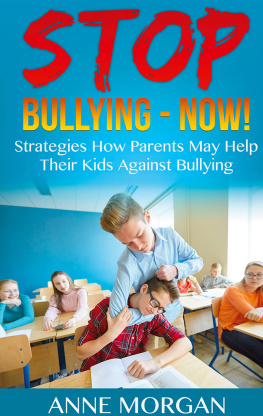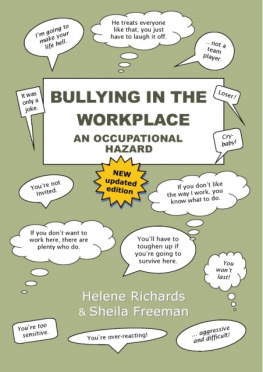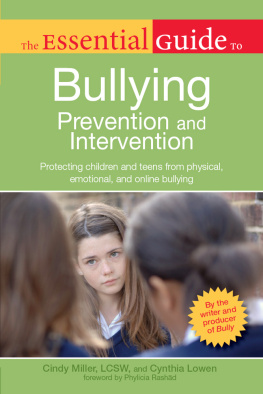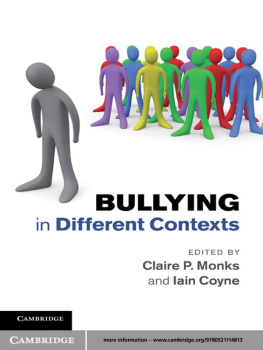2013 Gale, Cengage Learning
ALL RIGHTS RESERVED. No part of this work covered by the copyright herein may be reproduced, transmitted, stored, or used in any form or by any means graphic, electronic, or mechanical, including but not limited to photocopying, recording, scanning, digitizing, taping, Web distribution, information networks, or information storage and retrieval systems, except as permitted under Section 107 or 108 of the 1976 United States Copyright Act, without the prior written permission of the publisher.
Every effort has been made to trace the owners of copyrighted material.
LIBRARY OF CONGRESS CATALOGING-IN-PUBLICATION DATA
MacKay, Jenny, 1978-Bullying / by Jenny MacKay.
p. cm. - (Hot topics)
Includes bibliographical references and index.
ISBN 978-1-4205-0814-7 (hardcover)
1. Bullying-United States. 2. Bullying--United States--Prevention.
3. Bullying in schools--United States. 4. Bullying in schools-United States--Prevention. I. Title.
BF637.B85M234 2013
302.34'30973-dc23
2012028728
Lucent Books
27500 Drake Rd.
Farmington Hills, MI 48331
ISBN-13: 978-1-4205-0814-7
ISBN-10: 1-4205-0814-8
Printed in the United States of America
1 2 3 4 5 6 7 16 15 14 13 12


Y oung people today are bombarded with information. Aside from traditional sources such as newspapers, television, and the radio, they are inundated with a nearly continuous stream of data from electronic media. They send and receive e-mails and instant messages, read and write online blogs, participate in chat rooms and forums, and surf the web for hours. This trend is likely to continue. As Patricia Senn Breivik, the former dean of university libraries at Wayne State University in Detroit, has stated, Information overload will only increase in the future. By 2020, for example, the available body of information is expected to double every 73 days! How will these students find the information they need in this coming tidal wave of information? Ironically, this overabundance of information can actually impede efforts to understand complex issues. Whether the topic is abortion, the death penalty, gay rights, or obesity, the deluge of fact and opinion that floods the print and electronic media is overwhelming. The news media report the results of polls and studies that contradict one another. Cable news shows, talk radio programs, and newspaper editorials promote narrow viewpoints and omit facts that challenge their own political biases. The World Wide Web is an electronic minefield where legitimate scholars compete with the postings of ordinary citizens who may or may not be well-informed or capable of reasoned argument. At times, strongly worded testimonials and opinion pieces both in print and electronic media are presented as factual accounts.
Conflicting quotes and statistics can confuse even the most diligent researchers. A good example of this is the question of whether or not the death penalty deters crime. For instance, one study found that murders decreased by nearly one-third when the death penalty was reinstated in New York in 1995. Death penalty supporters cite this finding to support their argument that the existence of the death penalty deters criminals from committing murder. However, another study found that states without the death penalty have murder rates below the national average. This study is cited by opponents of capital punishment, who reject the claim that the death penalty deters murder. Students need context and clear, informed discussion if they are to think critically and make informed decisions.
The Hot Topics series is designed to help young people wade through the glut of fact, opinion, and rhetoric so that they can think critically about controversial issues. Only by reading and thinking critically will they be able to formulate a viewpoint that is not simply the parroted views of others. Each volume of the series focuses on one of todays most pressing social issues and provides a balanced overview of the topic. Carefully crafted narrative, fully documented primary and secondary source quotes, informative sidebars, and study questions all provide excellent starting points for research and discussion. Full-color photographs and charts enhance all volumes in the series. With its many useful features, the Hot Topics series is a valuable resource for young people struggling to understand the pressing issues of the modern era.
T HERE H AVE A LWAYS B EEN B ULLIES
Y oung kids scrape their knees, teenagers get acne, and everyone encounters a bully from time to time. For generations, society has accepted these as normal and expected plights of growing up. Most adults recall specific bullies or unpleasant bullying incidents from their younger days and are living proof that bullying can be survived. They share the prevailing wisdom that kids will be kids, bullying is temporary, and victims will get through it. However, dozens of well-publicized events since the 1990s have increasingly shown that bullying is not easy for everyone to tolerate, nor does everyone always live through it as conventional advice suggests. Bullying is widespread and pervasive, and it involves more than just schoolyard pranks and taunts. Its consequences can destroy a persons happiness and well-being and can even be deadly.
One event that put a spotlight on the modern bullying problem in America took place November 2, 1998, in a quiet suburban neighborhood near Atlanta, Georgia. A school bus was taking middle school and high school students home when two passengers got into an argument. One was eighth-grade student Josh Belluardo. The other was high school freshman Jonathan Miller, who, fellow bus passengers said, threw a cafeteria mustard or ketchup packet that struck the back of Belluardos head. The boys were neighbors who had lived on the same cul-de-sac for years. They did not have a history of being violent with each other, but they were not friends, either. The thrown condiment packet led to flared tempers, and the boys challenged each other to a fight once they got off the bus.
Belluardo exited the bus first and walked toward his house. Witnesses said Miller ran after Belluardo and punched him in the back of the head. Belluardo fell to the ground, where Miller kicked him in the leg and punched him in the face. Belluardo never got up. The hit to the back of his head had torn an artery in the base of his skull, and he went into a coma. On November 4, after spending two days on life support at a hospital, Bel-luardo died. The criminal charges against Miller elevated from assault to felony murder. In May 1999 the fifteen-year-old was convicted and sentenced to life in prison.
In this security camera footage, Eric Harris, left, and Dylan Klebold are shown carrying weapons in the Columbine High School cafeteria during their shooting rampage in 1999. Their attack was a response to being bullied for years.


















